This post is a comprehensive, step-by-step process to cook pork ribs. Tips from a BBQ Pitmaster is complete session with BBQ Brian Misko and this article is all about Steps for Smoking Pork Ribs.
Introduction to Cooking Ribs
After 15+ years cooking at BBQ pitmaster competitions across North America, there is one category that House of Q has won the most awards. From the very first contest in the spring of 2005 to winning first place at the World Food Championships, pork ribs are that award-winning category.
In this article, I, BBQ Brian will share the steps to smoking pork ribs like an award-winning pitmaster. The tips and lessons will cover start to finish in five steps which include:
SIDEBAR: This post is COMPREHENSIVE… it’s long. We know! But there’s a tonne of information, right? To help, there is a VIDEO too! It’s at the bottom of this article. Wanna jump to the video?
Step One – Choosing Pork Ribs, Preparing, and Seasoning
Choosing a cut of ribs; trimming; layers of flavour; preparing and setting up your cooker
Types of Ribs
The first thing to consider when choosing pork ribs is which cut do you want to cook. There are plenty of terms that consumers may hear or see when they go to the butcher shop or to a grocery store. These include: side ribs, back ribs, short ribs or even St Louis cut rubs… but what are the differences?
| Pork Back Ribs | Pork Side Ribs |
| Ribs cut adjacent to the spine, below the loin and often between 3 to 5 inches in size. | Ribs cut between the back ribs and the breast plate, below the pork belly and often between 4 to 6 inches in size. |
| Alternate terms: – baby back ribs (or simply ribs from younger or smaller pigs) – back ribs – loin ribs | Alternate terms and sub-cuts: – short ribs – plate ribs – St Louis cut ribs (where the soft bones/cartilage portions are removed leaving just bones) |
Choose which cut you want to cook – sides or backs – however just make sure they have some meat on them. Some butchers or processors will cut as much as possible off the ribs to make more money from bacon or for meatier pork chops while leaving only rib bones with little meat on them. These are not as good eating as a rib that has more meat on them.
For us at House of Q, we have been cooking meaty, pork back ribs for many years. We have chosen this cut over side ribs since they have a nice lean portion of meat from the loin on the topside of the ribs. The eating experience is delicious and after mastering the texture element of our cook, the judges have awarded us for what we have been doing.
Trim and Preparation
When you are ready to trim and prepare the ribs open the package and put them on a cutting board. Trim off any loose pieces of meat or fat pockets with a sharp knife that might hang off or dangle from the rack. It is okay to leave these on if you really want to but it’s one of those that steps that pitmasters take when they are preparing their ribs at a contest. The goal is to make the rack “square” and even in size, so the cooking process is comparable from one rack to the next. Of course, we also want to make the ribs look amazing!
On the front side of the ribs or the “meaty” side, you may need to trim fat pockets. This can be a challenge since you can leave divots or uneven thickness once trimmed. Plan and visualize each trim cut so you can trim just the fat part and not the meat. Carefully you can make the ribs very even and consistent from left to right. If you take your time at this step, the front side can be sculpted or even crafted to perfection!
Once the trimming is done, all pork ribs have a membrane on the back side or the inside of the rib cage that should be removed. Some butchers will do this before you buy the ribs, some do not. Most pitmasters choose to have this removed for two reasons. The first is for better seasoning and flavor penetration into the meat and the second reason is it is easier to bite through from a texture consideration. To peel it off, lift an edge of the membrane where the bones are cut. It will be slippery and hard to grasp however using a paper towel you can grab that membrane and usually pull the whole thing off. If the membrane tears into pieces, it may take a few tries to remove the membrane.
Planning the layers of flavor – cooking steps
A competition pitmaster will have a plan for each meat they are cooking at a contest – there’s usually four meats. This planning is likely something that has been developed, tested, honed, and practised over many contests or years of cooking. The point is, however, there are multiple planned steps where something is added to the previous steps for flavour or texture. To help you contemplate what to consider, here are some of the considerations for pork ribs:
| Stage | Things to Contemplate and Add to Your Cook Plan |
| Before the meat is in the cooker | Brining, injecting, marinating, slather/binder, one (or more rubs), and additional seasonings? |
| Getting into the second steps | More of the same from the first layer or a different layer of rub/seasonings, something sweet, juice, soda pop, flavoured alcohol, butter or margarine, even more smoke? |
| Using moisture to work for you | Spritz with juice, syrups, vinegars, sugars, more seasonings, soda pop or alcohols? |
| Finishing it all up | Glazing with sauce, pan drippings, more rub or seasonings? |
Rib Flavour from House of Q – Seasoning and adding flavor
Once your ribs are trimmed, shaped and ready for seasoning there are a couple of options for the first layer of flavor. Some pitmasters will contemplate brining, curing or even injecting their ribs so there is flavor on the inside of the meat as versus just on the surface. For us at House of Q, I have been brining ribs with a simple salt and sugar brine for many years and winning awards. This has provided both moisture and seasoning to the meat before I even add rub or sauces or even smoke to the ribs. Some pitmasters will accelerate the brining time by using a syringe and inject with a solution of salt, sugar, and other ingredients. Some brines or injections may include juices or ingredients to help with moisture such as phosphates.
Many pitmasters will apply a liquid layer to the ribs before the rub is applied. For me and House of Q we use Slow Smoke Gold BBQ Sauce as this layer. This “slather” allows the rub to stick to the ribs and helps with both flavor and texture development. The rub that we use is House of Q Competition Rib Rub which has specific spices that help distinguish the final flavor for our ribs. This is sprinkled on the back side of the ribs first. Make sure the middle of the ribs has as much seasoning as the edges. Before turning them over to season the other side, let them rest until the dryness of the rub becomes moist. Turn the ribs over and repeat the process on the front.
Once the back and the front of the ribs are seasoned, they can be wrapped and placed in a fridge however they can just as easily go right on your cooker too. There is little to no advantage to wait for the spices and seasonings to “do their thing” or penetrate the meat. For us, we just start cooking!
Each layer of flavor that you are adding at this step, are only the first layer amongst many. Each layer will add one more character to the final and ultimate flavor of the ribs. Be careful choosing how intense some ingredient may be since it may become too dominant in the end. An example of this is salt. If the brine is salty and the rub is salty and then at the end even a sauce or a glaze is salty the ribs may ultimately be too salty for the eaters or the judges. Plan each layer well!
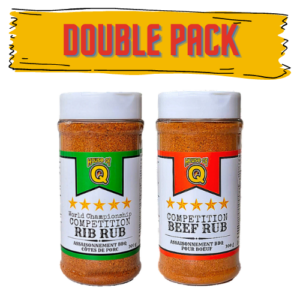 sale
saleCompetition Rub Pack
Original price was: $32.98.$28.98Current price is: $28.98.
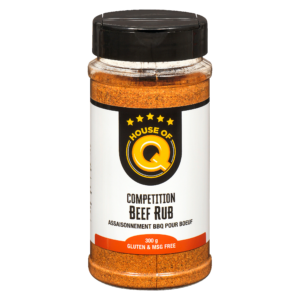 sale
saleCompetition Beef Rub
$16.99 – $42.99
 sale
saleCompetition Rib Rub
$15.99 – $39.99
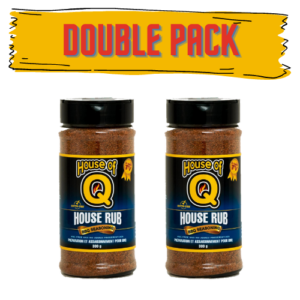 sale
saleHouse Rub Pack
Original price was: $31.98.$27.98Current price is: $27.98.
Preparing Your Smoker or Grill
As a competition Pitmaster, of course we use dedicated smokers. There are different technologies that every cook needs to decide what they want to work with from charcoal units, pellet, traditional offset smoker or at home gas or electric units are considerations. Whichever type of cooker you use, it is up to you to master how to control the temperature and air flow through the cooker. If there is a characteristic for EVERY pitmaster it would be this factor… that is, every cook needs to master how their gear works. Controlling a fire for even temperature without significant changes. They need to know how to make sure the heat, smoke and air is moving across whatever they are cooking evenly or where the hotspots are in the cook chamber. They need to be able to attend to their fire or fuel along with attending to the items they are cooking without disrupting the items being cooked.
For me and all of us at House of Q we have used many different types of cookers over the years from charcoal (Weber Smoky Mountain) to kamado style ceramic units (Primo) to the past number of years using pellet cookers from Yoder Smokers. We like using pellet technology from Yoder Smoker since it provides very good air flow through the cooking chamber, good temperature control, ease of use and the machines simply look sexy!
Now that our ribs are trimmed up, seasoned, the fire is going and everything is ready, let’s get to cooking!
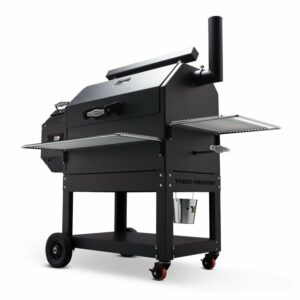
Yoder Smokers YS640s
$4,599.00
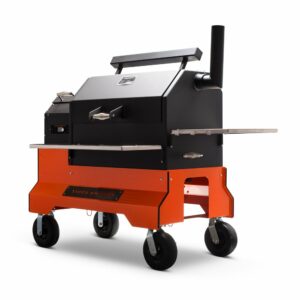
Yoder Smokers YS640s Competition Cart
$5,699.00

Yoder Smoker – Loaded Wichita
$5,175.00

Yoder Smokers YS480s
$3,975.00
Step Two – The First Cooking Step
Smoking and Establishing Character – What to Look For
Deciding the Cook Plan Before You Start
There are two general “paths” to cooking ribs for pitmasters. It is important to decide which path you want to do before you start cooking. Each path, or cook plan, requires slightly different tools to have in place or ingredients to have on hand.
The first “path” is to smoke the ribs for the complete cook leaving them open in the cooker without wrapping in foil or paper. We sometimes call this technique a ‘cook-to-finish’ or unwrapped rib plan.
The second “path” is to take advantage of different cooking methods through the cook plan which includes wrapping the ribs in foil or paper for a given period. This wrapped method takes advantage of the moisture inside the wrapping material to dissolve the connective tissue and to provide another opportunity for more flavour.
Either way you plan to smoke your ribs – wrapped or not wrapped, the criteria that the cook needs to master at each step is the same.
Establishing character – smoke, air flow and creating a crust
The first few hours smoking ribs is first of three important steps. The smoke is rolling, and the rub and slather are starting to dissolve and provide some character. The pork releases moisture into the cook chamber and the dry heat from the fire carries it away through the chamber and out the vents or stack.
In this step, regardless of which cook plan you’ve chosen, the goal is to establish “character” on your ribs. I describe this as a dry, smoky texture where the meat is around 155-170 F in temperature. If you were to touch the ribs, they would feel crusty. They would feel like sandpaper and at the same time the rub doesn’t come off on your finger. The meat will feel hard and “well-done” however at this point they are only half-way done for the entire cooking process.
For some cookers this step may take an hour to achieve, while others it may take a few hours. In any event, it is the crust you are trying to establish. Try to learn to cook without a clock so you can learn what your ribs are telling you. If your ribs are 160-170 F meat temperature and they are moist and soft, keep cooking for another 30 minutes to check again. See if the crust is established… then you know you can move along to the next step.
Step Three – Giving Your Ribs Some Love!
Different cooking methods; Using moisture and advancing your tenderness; spritz or wrap ingredients; tenderness tests
Once the ribs are dry and crusty, you are ready for the second cooking step. This stage is where the two cooking methods separate. One method will keep cooking open or unwrapped while the second method will wrap in foil. Either way the goal remains the same for the second stage… to develop tenderness.
If you choose to leave the ribs on the cooker and let them cook unwrapped, they will benefit from added moisture. Using a clean, empty spray bottle consider using fruit juices such as apple, pear or peach juice, soda pop such as Dr Pepper, Coca-Cola or the like or even tasty alcohols such as beer, spiced rum or whiskey. Ribs, pork overall actually, really like sugar and sweetness so adding sugar into the spritz helps too. Sweet options include maple syrup, brown sugar, honey or even agave syrups. The tip is to make sure the sugars are dissolved in the liquid before spritzing. Some cooks might even add some of their rub into the spritz. Whatever you choose, I’m sure you can see there are options! Just remember to coat both the front AND the back of the ribs. Spray every 30 minutes or so until the meat reaches the right tenderness.
If you choose to wrap your ribs in foil, you also have plenty of opportunity to add more flavour. Just like choosing the spritz ingredients, juices, sugar, syrups, soda pop or alcohol are common inside a wrapped packet of ribs. Some may add butter or margarine or even BBQ sauce. For us at House of Q, we stick to sugar, honey, and juices. The total volume in a foil packet is between three-quarters to one cup of sugar or liquid. Once added, wrap the ribs back up and put them back on the cooker at the same temperature.
Tests to know when ribs are tender
Once you have wrapped or spritzed for a couple of hours, the meat will start to become soft. As the collagen dissolves, the meat temperature will begin to rise from the first cooking stage temperature of 160 F to 190 F or more. A cook needs to be very mindful here, so the ribs don’t become too soft and over-cooked. We’re not making pulled pork today, we’re making ribs! The texture is slightly different.
Let’s remind ourselves of the goal here… that is to establish tenderness. This is when the ribs are soft, easy to bite through, not dry and the mouthfeel should be juicy and flavorful. Some cooks may lift the rack with tongs and feel for the pliability of the meat and how the rack folds. This is risky and inconsistent for a test but in a pinch, it works. If too soft and the rack is lifted from below, the surface can split or even break the rack in half. This might be fine in the backyard but not at a world championship.
Another test is to use a skewer or meat probe and to probe in-between the ribs to test how the meat feels. The probe should go into the meat and release without restriction. In short, it will feel like sticking a knife into a room temperature block of butter.
The best and most reliable method however is to use a thermometer. The meat temperature will be around 200 F. There is an “art” here… some cooks may want a tighter feel to the meat and shoot for 190 F while another cook might want 205 F or 208 F. You will need to establish what works for you. But through each of the different ways to test for meat for doneness, the best method is to use a meat thermometer.
Step Four – Finishing it All Up
Saucing as last layer of flavour; steps to master tenderness
At this time in the rib cook, the meat is soft and tender, and you might think it’s time to eat. There is still one more opportunity to master ribs like an award-winning pitmaster – the final cooking step.
This last layer is to glaze or to sauce the ribs and bring all of the flavour components from the previous steps in alignment. Choose a BBQ sauce to complement the other layers you have chosen for your cook plan. If the first layer is salty and the second steps offer sweetness, the final step might be to add some tanginess with a vinegar-based sauce. Whichever it is, plan well… it is the final opportunity for perfect flavour.
One big tip is to use the liquid you’ve created from inside the foil packets. This “syrup” has all the other layers that you applied early in the cooking process starting with your rub. Pour this off into a sauce pot and add your chosen BBQ sauce to that liquid. Heat the sauce which will allow the glaze to apply evenly and easily. If the sauce is cold, it can leave brush marks or even chill the ribs below your perfect meat temperature.
For us at House of Q, we have changed the sauce we use at competitions a few times. For many years we had our flagship Apple Butter BBQ Sauce as the key ingredient. We have added Sugar & Spice BBQ Sauce into that mixture for a while and even scrapped that completely and went with a sauce made with Slow Smoke Gold BBQ Sauce. All sauce options have won awards at BBQ contests. Our biggest run of awards though has been with Apple Butter, Sugar & Spice and the foil drippings all added together.
Saucing Ribs
After carefully removing the ribs from foil packets, start glazing on the back side of the ribs and brush on the sauce. Close the cooker and let the sauce become sticky – often 15 to 30 minutes of cooking time. Turn the ribs over to the topside and apply sauce to the front side. Again, close the cooker and let the sauce set on the ribs.
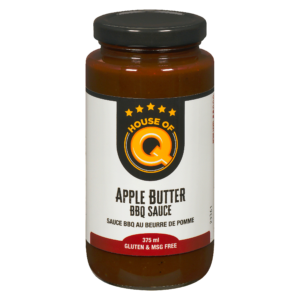 sale
saleApple Butter BBQ Sauce
Original price was: $11.79.$10.99Current price is: $10.99.
 sale
saleFive Star Competition BBQ Sauce
Original price was: $11.79.$10.99Current price is: $10.99.
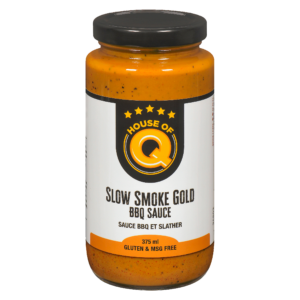 sale
saleSlow Smoke Gold BBQ Sauce
Original price was: $10.99.$9.99Current price is: $9.99.
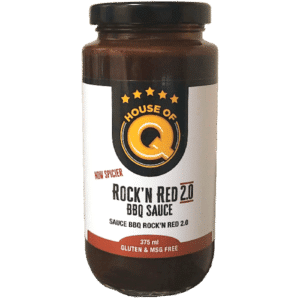 sale
saleRock’n Red 2.0 BBQ Sauce
Original price was: $10.99.$9.99Current price is: $9.99.
Step Five – Resting and Cutting Ribs
Resting and how to cut ribs into portions
Once the ribs are nicely glazed and caramelized, carefully remove them from the smoker and let them rest on a cutting board. This is an important step and will test your patience! Here’s something to encourage you from digging right in. The meat is around 200 F which will burn your lips and mouth instantly. Let the ribs rest to allow them to be moist and tender. For us at House of Q we often rest ribs for 30 minutes or more uncovered then cut them up for our tray going to the judges. At home when we are cooking for friends, they rest for usually only 15 minutes or so.
Cutting ribs, properly
When we are at a BBQ contest, we want to have perfection. Perfect flavour, perfect texture and of course ribs that look delicious!
We have seen cooks attempt to cut through ribs from the front face or the topside with disastrous results. This is a difficult cut since you can’t clearly see both ends of the rib bone and getting your knife to cut in-between the bones is the hard part. A goal of a nice straight cut can be skewed by hitting a bone or simply be stopped from progressing since you land directly on top of a bone.
An alternate way is to hold the ribs vertically with the top of the bones exposed. Holding the rack, a knife can then be run straight through the meat portion of the ribs. The downside here is that the cut can be uneven or crooked.
For us, we take ribs and place them meat side down on a cutting board. If you’ve done the three cooking steps properly and looked for the right clues at each step, the surface won’t be damaged by being pressed into the cutting board. The backside of the ribs will allow you to see precisely where the bones are from one edge to the other and where a perfect cut can be placed. The goal for a pitmaster is to make each rib bone the same size, shape and square. By cutting on the backside of the ribs, you can easily do this.
Summary
One sign of a good rib cook at home is a bunch of friends standing around licking their lips with a soiled-up paper towel in their hand and a pile of discarded, eaten bones on the table. Everyone is glowing with happiness from the goodness you just created. I’ve experienced this many times at a many different House of Q events including at home.
I know this multiple step plan might be too much for many cooks in their backyards, but it is ALL of the steps that award-winning pitmasters do at BBQ contests. If there was something to learn from this is that each planned stage offers something for flavour and for texture.
Another takeaway would be the sensory clues and description for the things to look for at each step of the cook. Establishing crust or bark, knowing when your ribs can come out of the foil packet and knowing what tender ribs feel like all relate to using your senses. It has nothing to do with a clock or the duration to cook at a given stage. If you pay attention to these clues, your rib cook will go well.
We wish you well and encourage you to re-create the multiple layers of House of Q flavour that we have mastered over the past fifteen years. Good luck and happy cooking!

